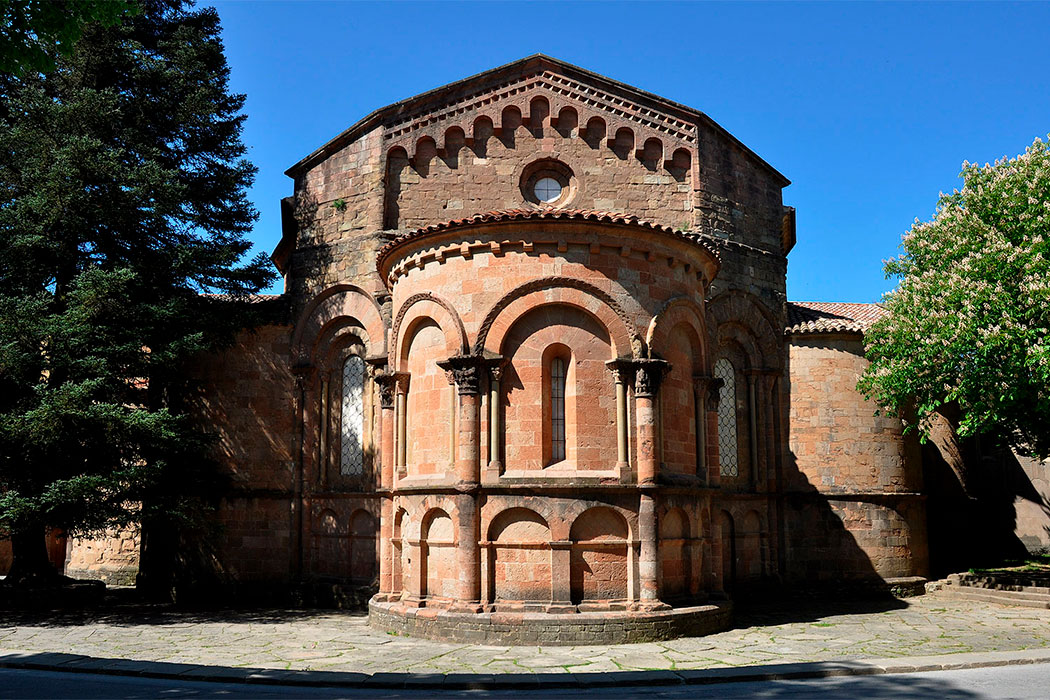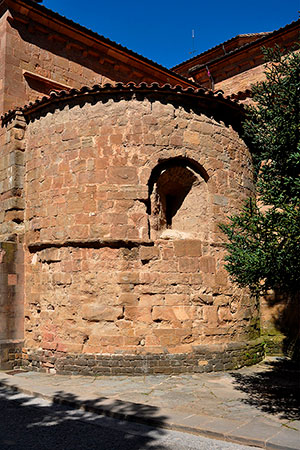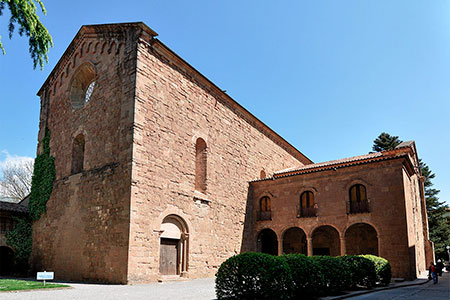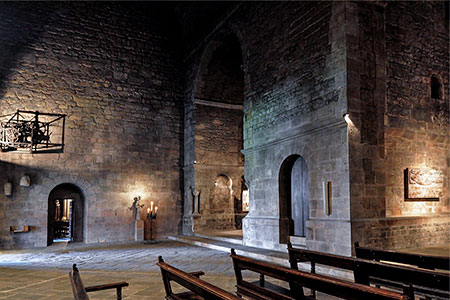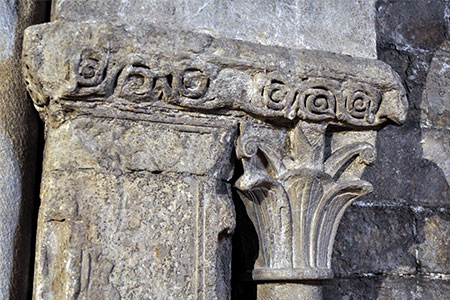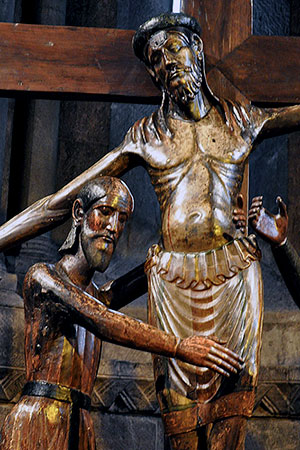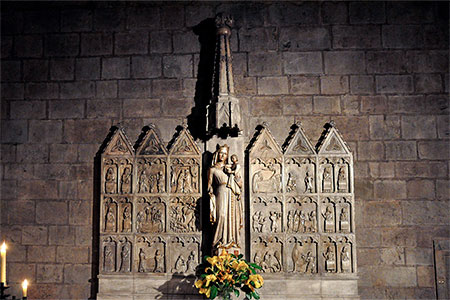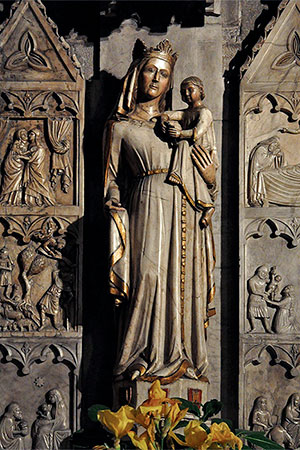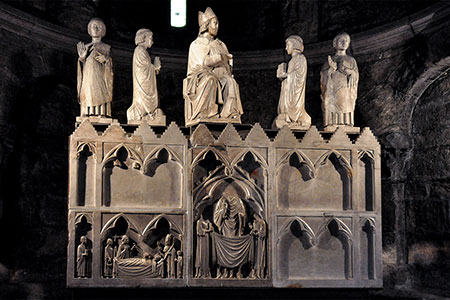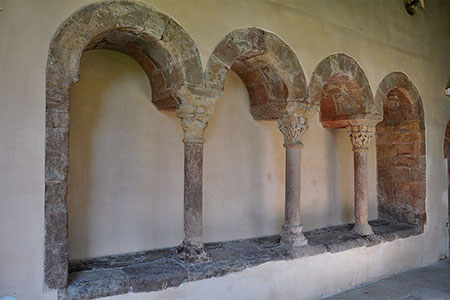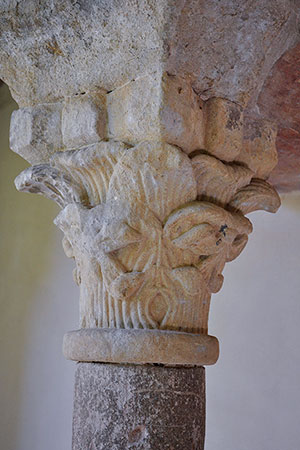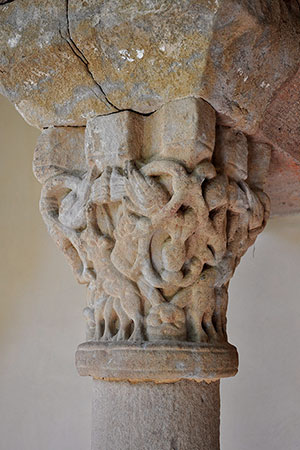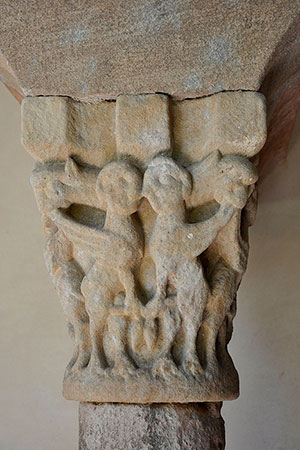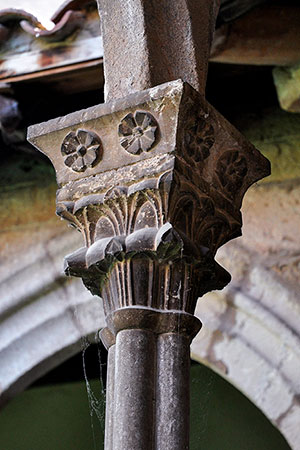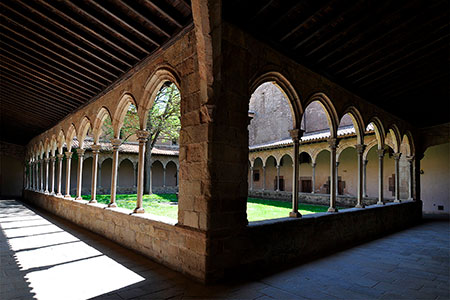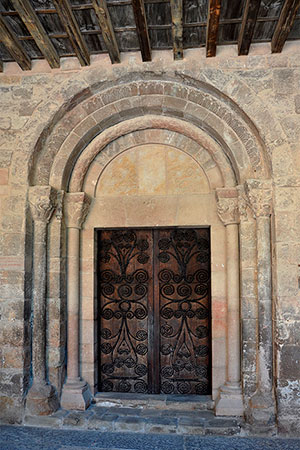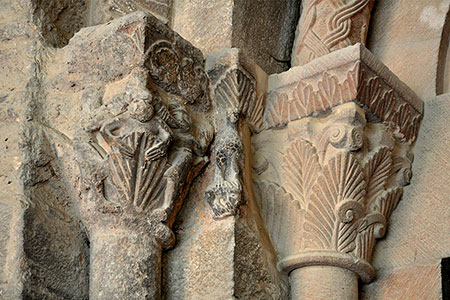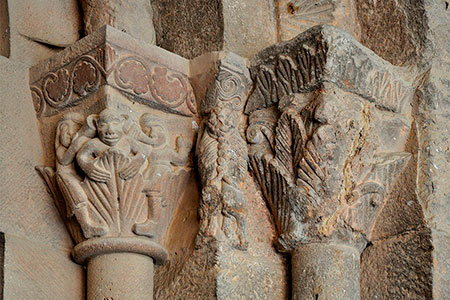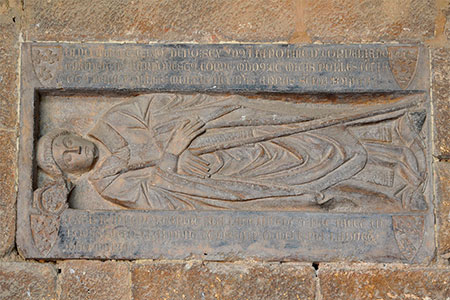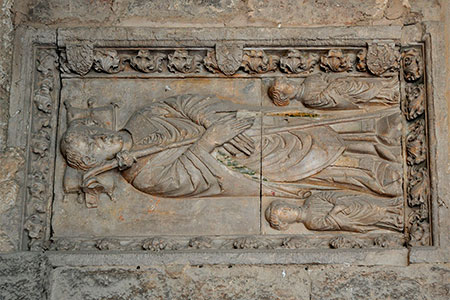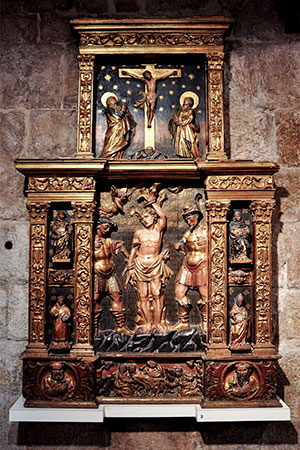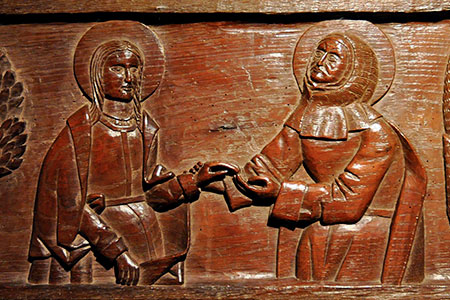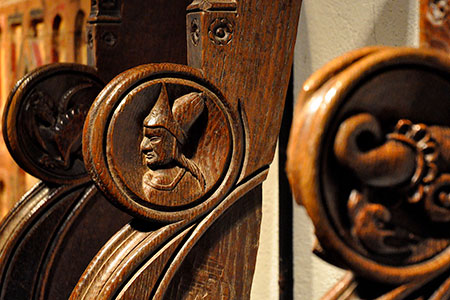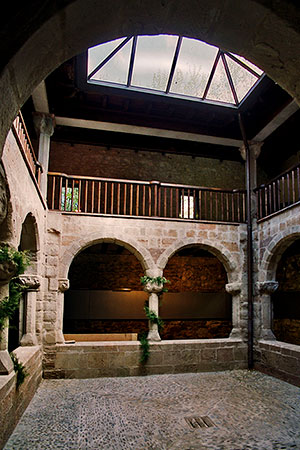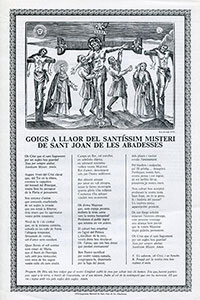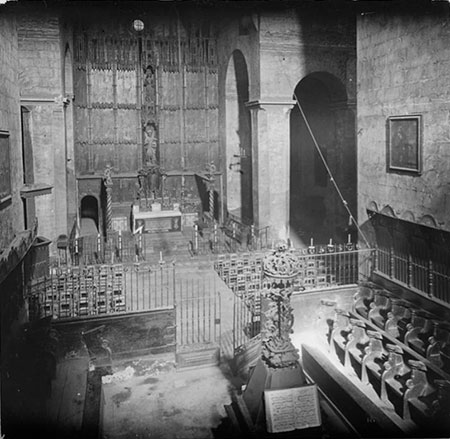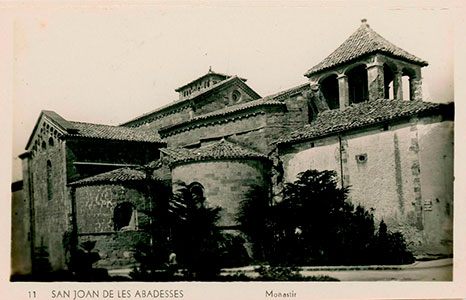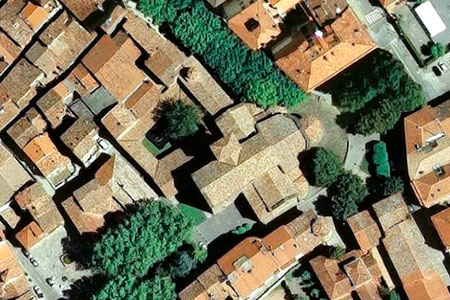Monastery of Sant Joan de les Abadesses
Sant Joan de Ripoll / Sancti Iohannis Baptiste
(Sant Joan de les Abadesses, Ripollès)
The foundation of the monastery of Sant Joan de les Abadesses, which was originally known as Sant Joan de Ripoll, was carried out shortly before 887 thanks to the will of Count Guifré (Wilfred the Hairy), with the aim of leaving it under the direction of his daughter Emma, who had been born shortly before, around 884.
The female Benedictine abbey
This task was carried out in a similar way to the foundation of the male monastery of Santa Maria de Ripoll and in order to promote the colonisation of these lands, which had already been occupied beforehand. To this end, he contributed a church dedicated to Saint John, which already existed in 880, when Guifré himself gave it to the monastery of Santa Maria de Ripoll. In 887, the renovated and enlarged monastery church was consecrated, and the act lists the important assets placed within the reach of the new monastery. It seems that the abbess Emma took over in 898, after the death of the count, at the age of fourteen.
Emma's abbacy was long (until 942) and was a period of splendour for the centre. Her wealth increased significantly, which meant that her succession was marked by disputes between the counties of Barcelona-Osona and Cerdanya over control of the domain. From Sant Joan, the foundation of other churches and establishments was encouraged, such as Santa Maria del Camí, placed under the direction of Quíxol, Emma's sister. The second abbess (Adelaida, 949-955) was the daughter of Count Sunyer of Barcelona, her successor (Ranlo, 955-c960) of Count Delà of Empúries, followed by Fredeburga (c960-994), related to the house of Cerdanya.
The last abbess was Ingilberga (994-1017), the natural daughter of the Count of Cerdanya Oliba Cabreta, who put an end to the Benedictine monastery when she was expelled, along with the rest of the community, because of serious accusations made by her half-brother Bernat Tallaferro regarding her moral conduct. The Count of Besalú, Bernat Tallaferro, probably intended to seize the monastery's assets to carry out his project to create a bishopric in Besalú. In any case, in 1017 the monastery was extinguished, and the community was forced to disperse.
Aachen canonry
It was then that a community of Aachen canons was established under the tutelage of the County of Besalú, which took advantage of the riches of the house of Sant Joan. This marked the beginning of a period of instability fomented by Ripoll, at that time linked to the monastery of St Victor of Marseille, which sought to impose a Benedictine community as the continuation of the previous one. These pretensions clashed with the opposition of the canonical community, under the protection of the bishop of Osona. These events ended in 1083 with the expulsion by force of arms of the canons, who were forced to seek protection in Vic.
Augustinian canonry
The Marseillaise monks quickly occupied the monastery, but finally the ecclesiastical authorities returned the house to the expelled canons in the same year, with the difference that they were subject to the Augustinian reformed rule instead of the Aachen observance.
Double Benedictine community
In 1098, the canons were expelled again and a community of nuns from Sainte-Perpétue de La Celle (Var) moved here, and it was from this time onwards that it began to be called Sant Joan de les Abadesses, instead of Sant Joan de Ripoll, the name by which it had been known until then. It was really a double community: on the one hand the nuns and on the other the Benedictine clerics who served it.
Augustinian canonry restored
This state of affairs continued until 1114, when the monastery was restored to the Augustinian canons who had remained united, but outside the monastery, the Benedictine communities that occupied it were forced to abandon it. In the same year, Pope Paschal II issued a bull approving the new situation and submitting the house to the Holy See. It was this community that established itself definitively on the site, inaugurating a new period of great vitality. In 1150 a new church, the present one, was consecrated. From 1484 onwards, the monastery was run by commendatory abbots, which aggravated the decline that had begun to be detected earlier. In 1581 the community effectively disappeared and in 1592 was secularised. The place continued to be governed by an archpriest until 1856, when the parish church of the town was transferred to the monastery church.
- ALBERT I CORP, Esteve (1999). Les abadesses de Sant Joan. Barcelona: R. Dalmau Ed.
- BRUGUÉS, Irene i altres (ed.) (2019. El monestir de Sant Joan. Primer cenobi femení dels comtats catalans (887-1017). Barcelona: P. Abadia de Montserrat
- COSTA, Xavier (2022). Poder, religió i territori. Una nova mirada als orígens del monacat al Ripollès. Barcelona: Un. Barcelona
- COSTA, Xavier (2019). Paisatges monàstics. El monacat alt-medieval als comtats catalans (segles IX-X). Tesi doctoral. Universitat de Barcelona
- CRISPÍ, Marta (ed.) (2012). El monestir de Sant Joan de les Abadesses. Junta del Monestir de Sant Joan de les Abadesses
- DANÉS I VERNEDAS, Joan (1912). La vall i el monestir de Sant Joan de les Abadesses. Barcelona: L’Avenç
- DANÉS I VERNEDAS, Joan (1926). Monestir de Sant Joan de les Abadesses. Barcelona: Taber
- GAVÍN, Josep M. (1978). Inventari d'esglésies. Vol. 4. Garrotxa - Ripollès. Barcelona: Artestudi Edicions
- JUNYENT, Eduard (1976). El monestir de Sant Joan de les Abadesses. Junta del Monestir de Sant Joan de les Abadesses
- PARASSOLS Y PI, Pablo (1859). San Juan de las Abadesas y su mayor gloria el Santísimo Misterio. Vic: Soler
- PLADEVALL, Antoni (1987). Catalunya romànica. Vol. X. El Ripollès. Barcelona: Enciclopèdia Catalana
- PLADEVALL, Antoni i altres (1995). Art i cultura als monestirs del Ripollès. Barcelona. P. Abadia de Montserrat
- RIPOLLÉS-PONSI, Joana; TRAYNER VILANOVA, Maria Pau (2008). Emma de Barcelona. Monestir de Sant Joan de les Abadesses. Barcelona: Ed. Mediterrània
- RIU, Manuel (1974). Posesiones del monasterio de Sant Joan de les Abadesses en el obispado de Urgell. Anales del Instituto de Estudios Gerundenses. Vol. 22
